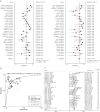Circulating miRNAs as Auxiliary Diagnostic Biomarkers for Multiple Myeloma: A Systematic Review, Meta-Analysis, and Recommendations
- PMID: 34307166
- PMCID: PMC8297545
- DOI: 10.3389/fonc.2021.698197
Circulating miRNAs as Auxiliary Diagnostic Biomarkers for Multiple Myeloma: A Systematic Review, Meta-Analysis, and Recommendations
Abstract
Multiple myeloma (MM) is a hematologic malignancy characterized by aberrant expansion of monoclonal plasma cells with high mortality and severe complications due to the lack of early diagnosis and timely treatment. Circulating miRNAs have shown potential in the diagnosis of MM with inconsistent results, which remains to be fully assessed. Here we updated a meta-analysis with relative studies and essays published in English before Jan 31, 2021. After steps of screening, 32 studies from 11 articles that included a total of 627 MM patients and 314 healthy controls were collected. All data were analyzed by REVMAN 5.3 and Stata MP 16, and the quality of included literatures was estimated by Diagnostic Accuracy Study 2 (QUADAS-2). The pooled area under the curve (AUC) shown in summary receiver operating characteristic (SROC) analyses of circulating miRNAs was 0.87 (95%CI, 0.81-0.89), and the sensitivity, specificity, positive likelihood ratio (PLR), negative likelihood ratio (NLR), and diagnostic odds ratio (DOR) were 0.79, 0.86, 5, 0.27, 22, respectively. Meta-regression and subgroup analysis exhibited that "miRNA cluster", patient "detailed stage or Ig isotype" accounted for a considerable proportion of heterogeneity, revealing the importance of study design and patient inclusion in diagnostic trials; thus standardized recommendations were proposed for further studies. In addition, the performance of the circulating miRNAs included in MM prognosis and treatment response prediction was summarized, indicating that they could serve as valuable biomarkers, which would expand their clinical application greatly.
Systematic review registration: https://www.crd.york.ac.uk/prospero/display_record.php?RecordID=234297, PROSPERO, identifier (CRD42021234297).
Keywords: biomarker; diagnosis; meta-analysis; microRNAs; multiple myeloma.
Copyright © 2021 Xiang, Zhang, Xiang and Zhang.
Conflict of interest statement
The authors declare that the research was conducted in the absence of any commercial or financial relationships that could be construed as a potential conflict of interest.
Figures






Similar articles
-
MicroRNA panels as diagnostic biomarkers for colorectal cancer: A systematic review and meta-analysis.Front Med (Lausanne). 2022 Nov 7;9:915226. doi: 10.3389/fmed.2022.915226. eCollection 2022. Front Med (Lausanne). 2022. PMID: 36419785 Free PMC article.
-
Diagnostic accuracy of circulating miRNAs to discriminate hepatocellular carcinoma from liver cirrhosis: a systematic review and meta-analysis.Front Med (Lausanne). 2024 Apr 24;11:1359414. doi: 10.3389/fmed.2024.1359414. eCollection 2024. Front Med (Lausanne). 2024. PMID: 38721351 Free PMC article.
-
Diagnostic value of circulating microRNAs in thyroid carcinoma: A systematic review and meta-analysis.Clin Endocrinol (Oxf). 2020 Oct;93(4):489-498. doi: 10.1111/cen.14217. Epub 2020 May 26. Clin Endocrinol (Oxf). 2020. PMID: 32379941
-
The potential of circulating microRNAs as novel diagnostic biomarkers of COVID-19: a systematic review and meta-analysis.BMC Infect Dis. 2024 Sep 19;24(1):1011. doi: 10.1186/s12879-024-09915-8. BMC Infect Dis. 2024. PMID: 39300343 Free PMC article.
-
Diagnostic Accuracy of Artificial Intelligence Based on Imaging Data for Preoperative Prediction of Microvascular Invasion in Hepatocellular Carcinoma: A Systematic Review and Meta-Analysis.Front Oncol. 2022 Feb 24;12:763842. doi: 10.3389/fonc.2022.763842. eCollection 2022. Front Oncol. 2022. PMID: 35280776 Free PMC article.
Cited by
-
miRNAs and Multiple Myeloma: Focus on the Pathogenesis, Prognosis, and Drug Resistance.Technol Cancer Res Treat. 2023 Jan-Dec;22:15330338231202391. doi: 10.1177/15330338231202391. Technol Cancer Res Treat. 2023. PMID: 37728167 Free PMC article. Review.
-
Clinical Significance of microRNAs in Hematologic Malignancies and Hematopoietic Stem Cell Transplantation.Cancers (Basel). 2023 May 8;15(9):2658. doi: 10.3390/cancers15092658. Cancers (Basel). 2023. PMID: 37174123 Free PMC article. Review.
-
MicroRNA-665 and its potential role in drug response and survival outcomes in multiple myeloma: a preliminary study.Front Pharmacol. 2025 Apr 4;16:1465814. doi: 10.3389/fphar.2025.1465814. eCollection 2025. Front Pharmacol. 2025. PMID: 40255571 Free PMC article.
-
A thematic analysis of prognostic, diagnostic, and therapeutic of circulating miRNA biomarkers in bortezomib-resistant multiple myeloma.SAGE Open Med. 2025 Apr 26;13:20503121251328486. doi: 10.1177/20503121251328486. eCollection 2025. SAGE Open Med. 2025. PMID: 40297788 Free PMC article. Review.
-
Implication of microRNAs in Carcinogenesis with Emphasis on Hematological Malignancies and Clinical Translation.Int J Mol Sci. 2022 May 23;23(10):5838. doi: 10.3390/ijms23105838. Int J Mol Sci. 2022. PMID: 35628648 Free PMC article. Review.
References
-
- Kyle R, Durie B, Rajkumar S, Landgren O, Blade J, Merlini G, et al. . Monoclonal Gammopathy of Undetermined Significance (MGUS) and Smoldering (Asymptomatic) Multiple Myeloma: IMWG Consensus Perspectives Risk Factors for Progression and Guidelines for Monitoring and Management. Leukemia (2010) 24(6):1121–7. 10.1038/leu.2010.60 - DOI - PMC - PubMed
Publication types
LinkOut - more resources
Full Text Sources

